An endless onslaught of machine gun fire rains from above as explosions shake the ground. You have nowhere to go except forward, toward the enemy who is determined to make you another lifeless body on the beach.
This was the reality for the first 156,000 American, British, and Canadian soldiers that landed on the beaches of Normandy on June 6, 1944, D-Day. Take a rare glimpse into the reality of D-Day in color. From the painstaking preparations to the months of fighting at the Battle of Normandy, see what happened first-hand during one of the most pivotal and horrific battles of World War II.
Heading Onto The Ships
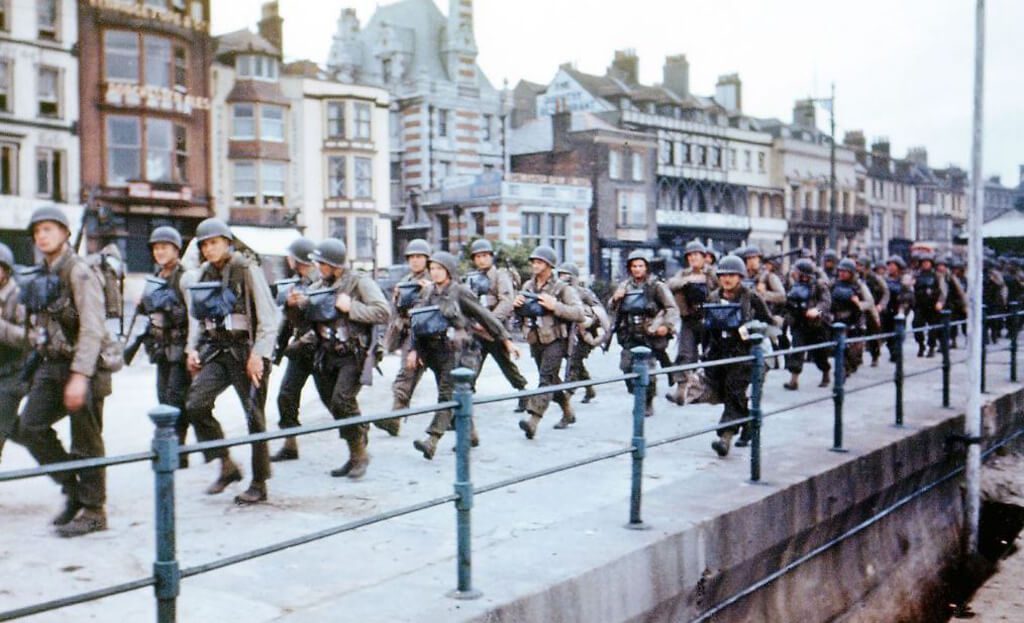
Here, U.S. troops are marching to board ships in Weymouth, Dorset in England. These soldiers are bound for Omaha Beach for the D-Day invasion. Unfortunately, very little planning went into the landing at Omaha. There were difficulties with navigation, and many ships ended up landing in the wrong spot, spreading disorganized troops throughout the beach.
The defenses were also particularly strong at the Omaha Beach drop and inflicted astronomical casualties on the landing American troops. Because the soldiers suffered such massive losses when landing, they had an even harder time clearing the defenses and obstacles on the beach.
ADVERTISEMENT
Loading Everything Necessary For The Assault
ADVERTISEMENT

ADVERTISEMENT
Not just soldiers were loaded on the ships in preparation for the D-Day landing. They made sure to bring everything that they could in preparation for the worst. The infantry would be carrying assault rifles, sidearms, medical equipment, explosives, and other heavy machine guns.
ADVERTISEMENT
However, they also brought vehicles such as M4 Tractors, Harley-Davidson WLAs, Armored Reconnaissance Vehicles, Heavy Transport Vehicles, Jeeps, Infantry Fighting Vehicles, and more. All of these vehicles and equipment would be essential to the success of the invasion. In the photo, we can see a U.S. army ambulance entering a Landing Craft Vehicle on June 1, in Southern England.
ADVERTISEMENT
The Deadliest Table
ADVERTISEMENT
ADVERTISEMENT

ADVERTISEMENT
An American soldier eats his lunch on an ammunition stockpile while taking a break from loading the ships in the days leading up to the assault. Running out of ammunition was not an option once on the beaches, so the Allies came prepared. Altogether, there were around 11.6 million carbines and rifles, 2.8 million pistols and revolvers, 2.3 million submachine guns, 1.5 million crew-served machine guns, and 188,000 automatic rifles.
ADVERTISEMENT
There were also around 19 million small arms, along with 57 billion rounds of small arms ammunition. These were mostly just for the infantry storming the beaches and for backup since there was no telling how long it would take.
ADVERTISEMENT
Waiting For The Signal
ADVERTISEMENT
ADVERTISEMENT

ADVERTISEMENT
Here, a group of American soldiers waits for the signal to begin the invasion across the English Channel on June 5, 1944. They had just finished loading the equipment onto a Landing Ship Tank and are now anxiously waiting to get a full taste of war. The invasion was initially planned to launch on June 4, however, was postponed due to bad weather.
ADVERTISEMENT
There was no way that they were going to risk everything on account of conditions that they could wait out. So, after the bad weather cleared, on the eve of June 5, the order was given, all 156,000 troops crossed the channel overnight. The real fighting began the next morning, June 6.
ADVERTISEMENT
Ready For A Fight
ADVERTISEMENT
ADVERTISEMENT
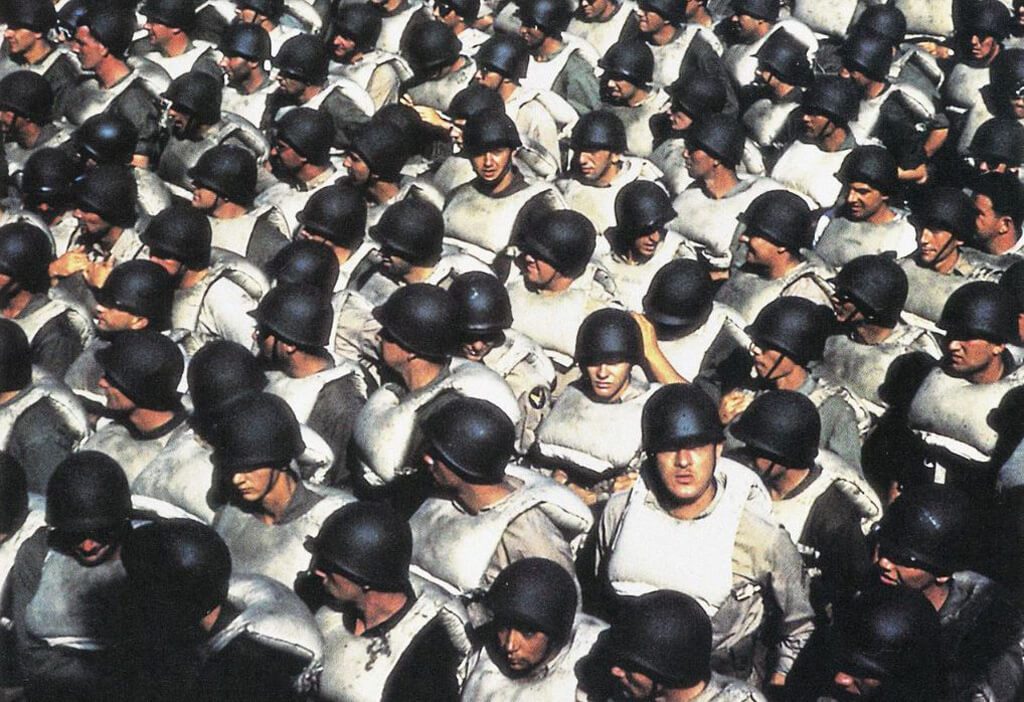
ADVERTISEMENT
While on their way to the French coast, some groups of U.S. soldiers were fitted with life vests while crossing the channel in landing crafts. For the most part, the plan to land on the beaches of Normandy that day remained a covert operation. General Eisenhower had been appointed the commander of D-Day, Operation Overlord, and he devised a plan to increase the success of the invasion.
ADVERTISEMENT
In the weeks and months leading up, he created a diversion to make it look like the invasion was going to occur at Pas-de-Calais, the narrowest point between England and France. This misled the Germans by using fake equipment, a phantom army, double agents, and fake radio transmissions.
ADVERTISEMENT
Prepare To Engage
ADVERTISEMENT
ADVERTISEMENT
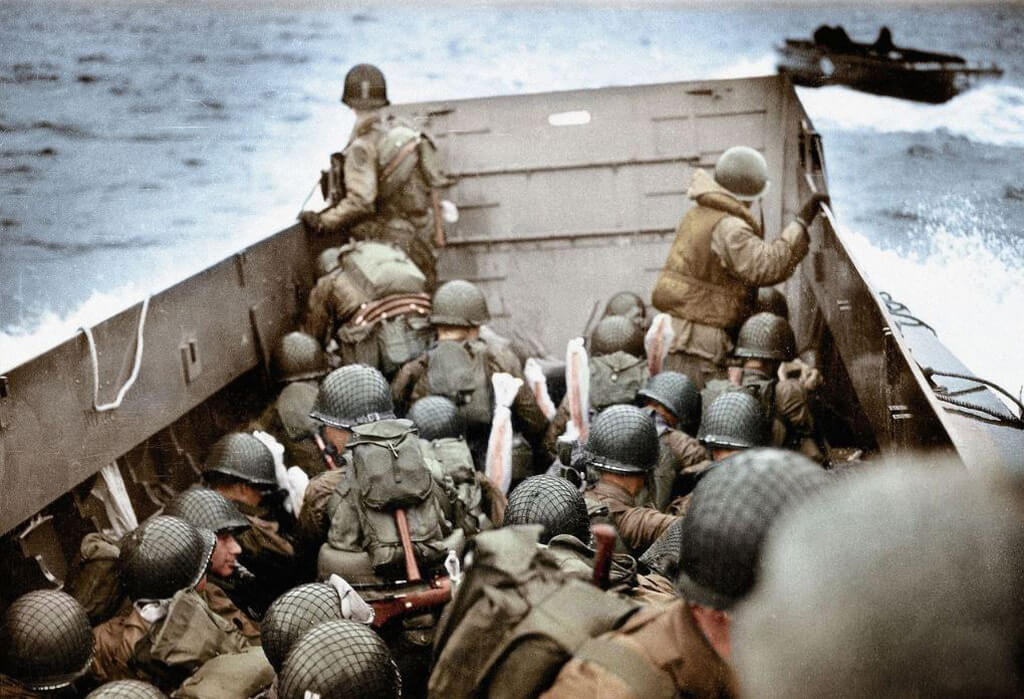
ADVERTISEMENT
At 6:30 a.m. on June 6, 1944, the Allied troops reached the beaches of Normandy and the invasion was in full swing. Troops were loaded into smaller landing crafts and taken from the larger crafts and onto the beach. Luckily, Allied paratroopers and gliders were already behind enemy lines, securing bridges and exit roads for the amphibious invasion.
ADVERTISEMENT
The fighting on the beach was horrific with over 10,000 Allied soldiers killed, wounded or missing during the day’s assault. However, by the end of the day, approximately 156,000 Allied troops had successfully overrun the beaches of Normandy.
ADVERTISEMENT
The Eye Of The Storm
ADVERTISEMENT
ADVERTISEMENT

ADVERTISEMENT
After the initial fighting on the beaches was over, three American soldiers from the First Engineer Special Brigade reminisce about home while sharing photos on Omaha Beach. Less, than a week later after D-Day, by June 11, the beaches had been fully secured and had been filled with over 326,000 Allied troops, 50,000 vehicles, and more than 100,000 tons of equipment.
ADVERTISEMENT
Although the victory at Normandy was a massive success and turning point in the war, there was still much more fighting to be done, and many more lives would be lost.
ADVERTISEMENT
Normandy Had Been Won
ADVERTISEMENT
ADVERTISEMENT
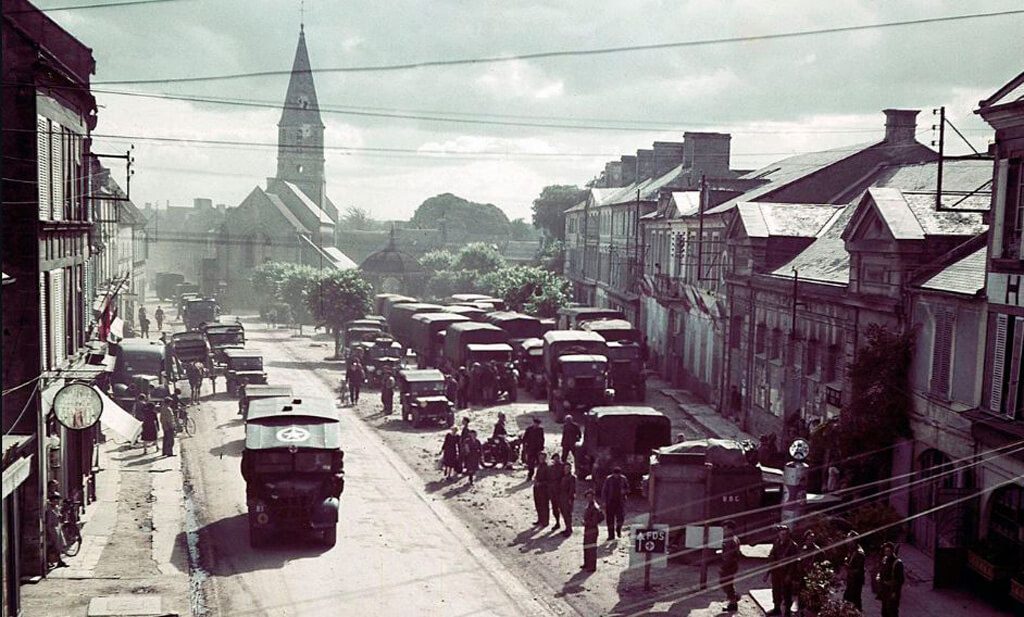
ADVERTISEMENT
In the weeks following the initial invasion, the Allies continued to fight their way through the Normandy countryside and close-quarters in the surrounding towns. By the end of June, the Allies had secured the port of Cherbourg and continued to land more soldiers and vehicles into the area to continue their tactical push into France.
ADVERTISEMENT
It wasn’t long until there were over 850,000 troops and 150,000 vehicles in Normandy. Featured above are U.S. infantry, trucks, and jeeps entering a town in Normandy after a hard-fought victory. Here, soldiers would regroup, and plans would be made for future action.
ADVERTISEMENT
The Assault Takes Its Toll On France
ADVERTISEMENT
ADVERTISEMENT
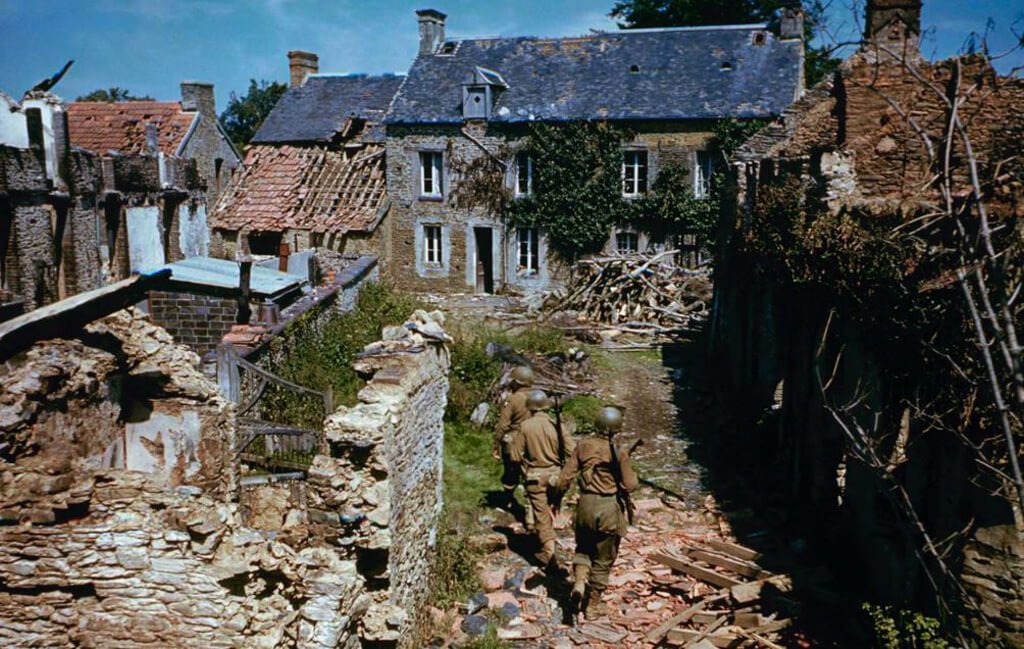
ADVERTISEMENT
Featured above is a photo of American troops walking through what are now war-torn areas of Normandy. Unfortunately, the surrounding area and towns of Normandy became one big combat zone where civilians were killed and entire cities were destroyed in the fighting. The Germans had also become increasingly determined to prevent the Axis from losing any more ground, leading to especially fierce combat.
ADVERTISEMENT
This also made fighting more dangerous with plenty of places for soldiers to take cover and snipers to hide. This meant that the Allies were forced to clear houses and find themselves in dangerously close quarters while fighting the enemy.
ADVERTISEMENT
The Battle Of Saint-Lô
ADVERTISEMENT
ADVERTISEMENT
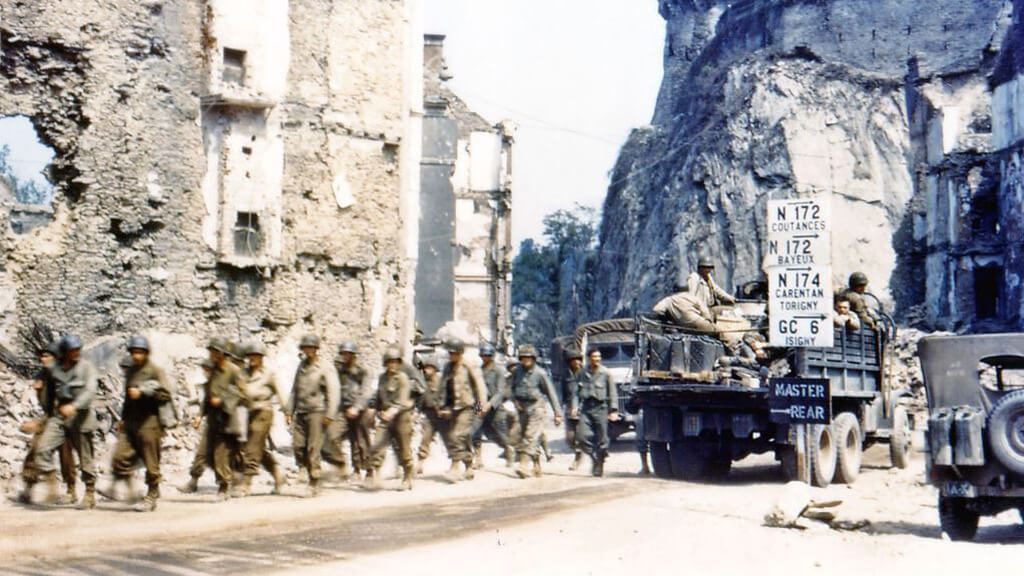
ADVERTISEMENT
Here, U.S. infantry and soldiers walk through the ruins of Saint-Lô in July 1944. The Battle of Saint-Lô was one of the three major conflicts in the Battle of the Hedgerows which occurred between July 9 through July 24. After the invasion of Normandy, Saint-Lô was still in German control and Americans decided it was necessary to win back because of its strategic crossroads.
ADVERTISEMENT
So, U.S. troops began major bombardment on the city where up to 95% of it was entirely destroyed, also creating a significant amount of casualties. The city then earned the name “The Capital of Ruins” which was coined by writer Samuel Beckett.
ADVERTISEMENT
The Ruins Of Saint-Lô
ADVERTISEMENT
ADVERTISEMENT
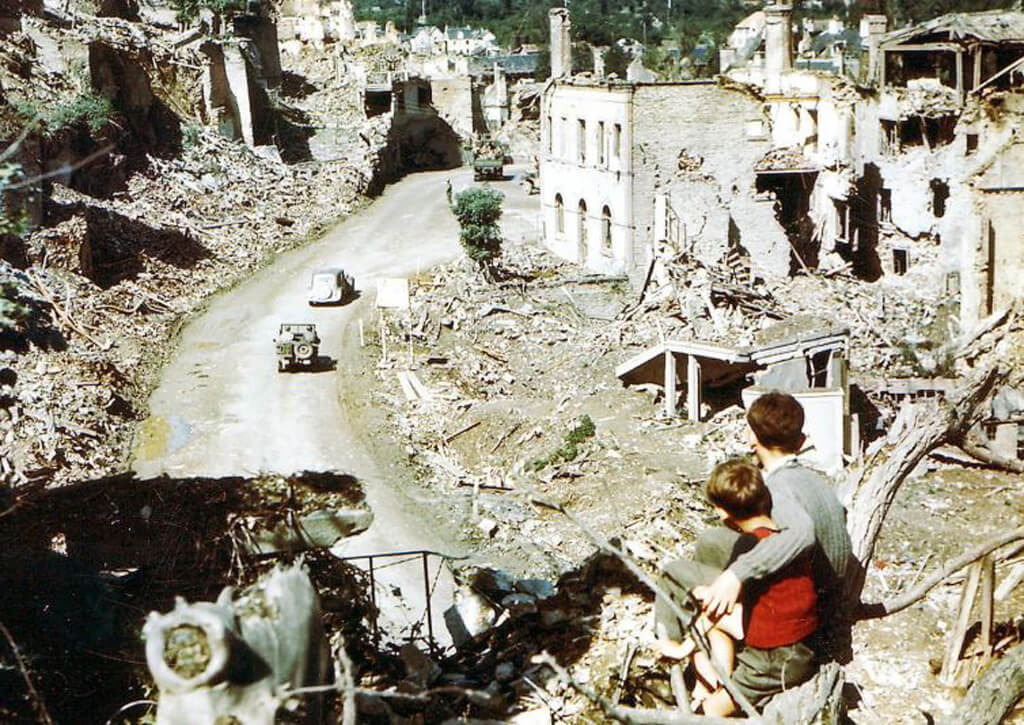
ADVERTISEMENT
Above, two young boys watch as U.S. Army jeeps drive through the remains of Saint-Lô, France in August 1944. By the end of August, the Allies had reached the Seine River. Not long after, Paris was liberated from the Nazi regime, and all but a few German troops had been removed from northwestern France.
ADVERTISEMENT
This concluded the Battle of Normandy. Now, the Allied forces prepared themselves to invade Germany where they had made plans to meet up with the Soviet troops from the east and ultimately bring down the Nazi regime.
ADVERTISEMENT
Welcomed With Open Arms By French Civilians
ADVERTISEMENT
ADVERTISEMENT

ADVERTISEMENT
The invasion of Normandy had resulted in the catastrophic destruction of French civilians’ homes. Yet, the Allied forces were still welcomed by the French civilians who were thankful for no longer being under German occupation. The Normandy invasion was one of the first major wins for the Allies and began to turn the war in favor of the Allies.
ADVERTISEMENT
The Germans would no longer be able to send troops from France to the Eastern Front to engage the encroaching Soviets which would prove to be a critical issue for the Germans towards the end of the war.
ADVERTISEMENT
Behind The Barbed-Wire Of A Jewish Ghetto
ADVERTISEMENT
ADVERTISEMENT

ADVERTISEMENT
Here, Jewish women talk behind the barbed-wire of the Kutno ghetto in 1940. The Kutno ghetto was around until 1942 after most of its inhabitants had been taken to the Chelmno extermination camp located 30 miles north of the Polish city of Lodz. The photographer of this image, Hugo Jaeger, was a member of the Nazi Paty and supporter until its collapse in 1945.
ADVERTISEMENT
Hitler was amazed by Jaeger’s photography and even claimed that “The future belongs to color photography.” Jaeger traveled to Poland in 1940 where he took pictures of the Kutno ghetto as well as the parades after the blitzkrieg of Poland.
ADVERTISEMENT
Makeshift Graveyard In Warsaw
ADVERTISEMENT
ADVERTISEMENT
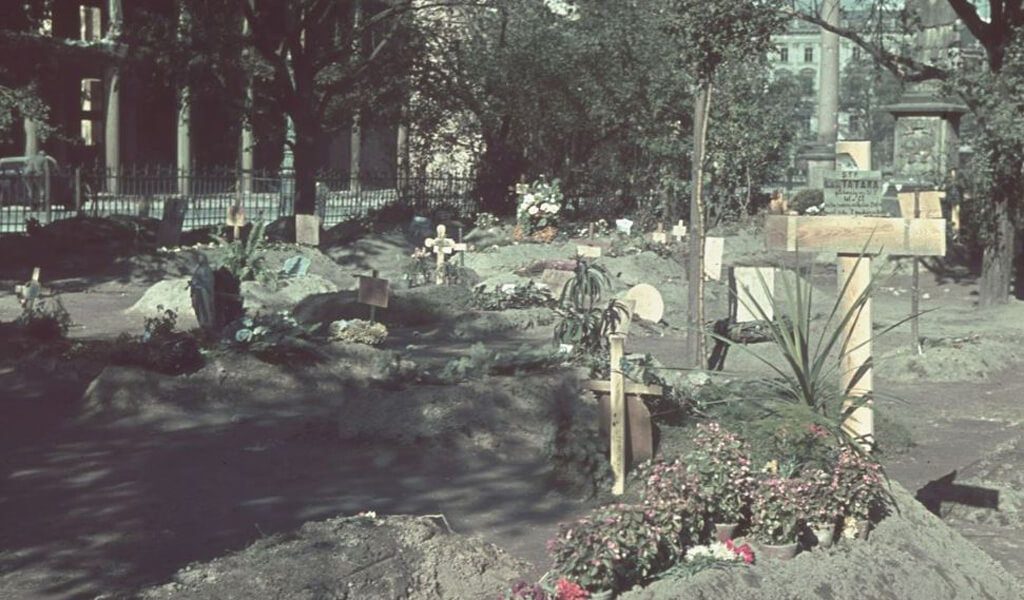
ADVERTISEMENT
On September 1, 1939, Germany began to invade Poland. Not long after on September 17, its ally the Soviet Union joined in to help the Germans. The attacks came from the land, sea, and air.
ADVERTISEMENT
Completely overwhelmed and in a hopeless fight, the citizens of Warsaw were forced to resort to burying their dead in makeshift graves wherever the ground was suitable to bury bodies. This image shows the absolute devastation that occurred in the city and the number of innocent lives that were lost in the assault on Poland.
ADVERTISEMENT
Never Even Had A Chance
ADVERTISEMENT
ADVERTISEMENT

ADVERTISEMENT
Above are unfinished Polish bombers that are wasting away at the Okezie military airport near Warsaw. The picture was taken not long after the German invasion on September 1, 1939. The official act of war against Poland was by the German air force, the Luftwaffe, on the Polish town of Wieluń.
ADVERTISEMENT
Not long after the Luftwaffe attack, a German battleship began to open fire on a Polish garrison stationed on the Westerplatte peninsula positioned on the Baltic coast. Although nobody knew it, it was at this exact moment that World War II had begun.
ADVERTISEMENT
Hitler’s Right-Hand Man
ADVERTISEMENT
ADVERTISEMENT
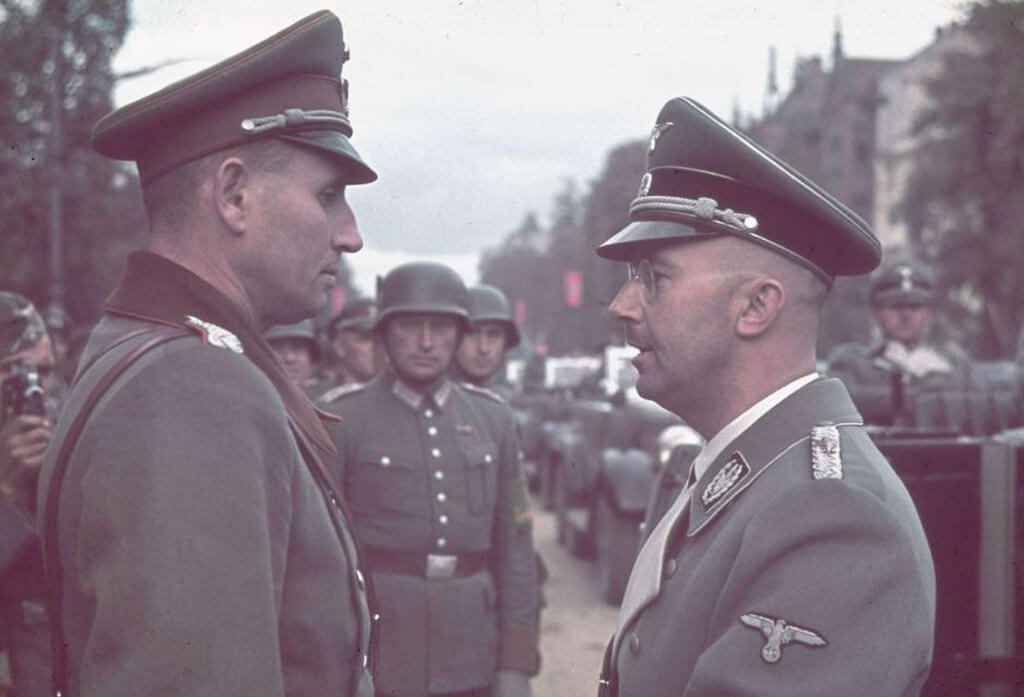
ADVERTISEMENT
The man on the right in the photograph is Heinrich Himmler. From 1929 to 1945, he was the Reich Leader of the SS squadron of the Nazi Party. His position made him the second most powerful man in Germany and was considered to be Hitler’s, right-hand man. Himmler is also credited as being the person who came up with the idea for the mass genocide of the Jewish people.
ADVERTISEMENT
The United States Holocaust Museum states that “Himmler was the key and senior Nazi official responsible for conceiving and overseeing implementation of the so-called Final Solution, the Nazi plan to murder the Jews of Europe.”
ADVERTISEMENT
Forced Labor
ADVERTISEMENT
ADVERTISEMENT

ADVERTISEMENT
Here, Polish women are forced to clean and maintain captured Polish weaponry at the Modlin fortress just north of Poland. This picture was taken after the German invasion of their country where Polish women and men were forced to work under German occupation.
ADVERTISEMENT
There is no record of what the fate of these women was whether they were placed into ghettos, put to work in factories, or sent to an extermination camp. Along with these women, millions of Polish citizens were captured and forced to labor as well as citizens of the other countries that were eventually occupied by the Nazi regime.
ADVERTISEMENT
Working In The Ghetto
ADVERTISEMENT
ADVERTISEMENT

ADVERTISEMENT
Jewish men are wearing the Star of David badge and working to rebuild a damaged part of the Kutno Ghetto in 1940. The Kutno Ghetto was once a sugar factory that was turned into a ghetto by adding barbed wire and German guards were put in place to prevent escape. Inside of the ghetto, death was no stranger whether it was from starvation or disease.
ADVERTISEMENT
Eventually, all residents of the ghetto were sent to die at Chelmo, one of the first constructed Nazi death camps. Three years later, in January 1945, the Soviet Army who had turned on their once German allies, retook Kutno where no Jews remained and had been killed.
ADVERTISEMENT
Armed With A Patriotic Sense Of Duty
ADVERTISEMENT
ADVERTISEMENT

ADVERTISEMENT
Armed with their weapons and a smile, American troops traveled the English Channel on a barge as they prepared to fight in Normandy, Franco for the D-Day Invasion that helped change the course of World War II.
ADVERTISEMENT
In the background, you see an American flag that flapped in the wind. Patriotism remained high even as many soldiers watched their fellow soldiers lose their lives in one of the most brutal wars the world had ever witnessed. Flags from America and our allies would soon be hung along Omaha Beach after the beach was won.
ADVERTISEMENT
No Mercy For Children
ADVERTISEMENT
ADVERTISEMENT

ADVERTISEMENT
In 1940, children pose in front of their makeshift home inside of the Kutno Ghetto. Between 1939 and 1945, around 1.5 million Polish citizens were either deported to German territories for forced labor or sent to Nazi concentration camps. During this time, it is also estimated that the Nazi regime killed over 1.9 million non-Jewish Polish citizens and killed over 3 million Jewish citizens.
ADVERTISEMENT
Among these numbers were countless women, children, and those unable to work for the German war machine as it continued to ravage Europe.
ADVERTISEMENT
No Home Left
ADVERTISEMENT
ADVERTISEMENT

ADVERTISEMENT
After the German invasion of Poland in 1939, most of the country looked as destroyed and empty as the picture above. Towns and cities were bombed and the residents were taken from their homes and forced into labor or led off to die. However, during this time, the once-Polish government worked with the Allied forced and formed an underground resistance to fight back.
ADVERTISEMENT
Their original headquarters were located in Paris but was later moved to London. Unfortunately, regardless of the Allies and the Polish resistance, by the end of the war, only one in ten Jews living in Poland had survived.
ADVERTISEMENT
Storming The Beach And ‘Into The Jaws Of Death’
ADVERTISEMENT
ADVERTISEMENT

ADVERTISEMENT
This stirring photo was captured by photographer Rober F Sargent of the United States Army First Infantry Division. He captured the photo in black and white just as his LCVP (landing craft) was arriving at Omaha Beach during the Normandy Landings on D Day.
ADVERTISEMENT
Titled, “Into The Jaws Of Death,” the aptly named photo was eventually colorized for dramatic effect. As World War II started to wind down it was photos like this one that reminds us of the horrors our troops faced on June 6, 1944.
ADVERTISEMENT
Tending To Injured Troops On Omaha Beach
ADVERTISEMENT
ADVERTISEMENT
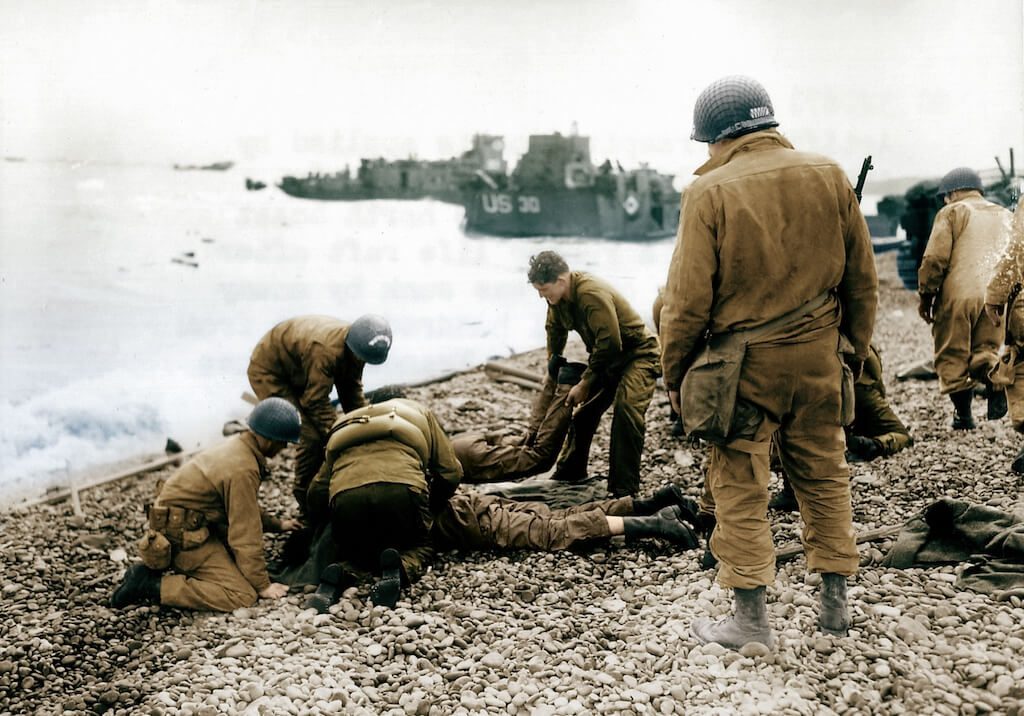
ADVERTISEMENT
This photo was taken as part of “Operation Overlord” which occurred at Omaha Beach on June 6, 1944. Iconic images of soldiers storming the beach are fairly common but they also had to deal with the after-effects of their battle.
ADVERTISEMENT
The men photographed here were from the 5th or 6th Engineer Special Brigade which can be spotted because of their helmet with the white arc and Jump Boots. The Landing Craft Tank (LCT) 30 in the background was part of Force O-2 attached to the 116th Infantry Division.
ADVERTISEMENT
US Rangers Bound For Normandy
ADVERTISEMENT
ADVERTISEMENT
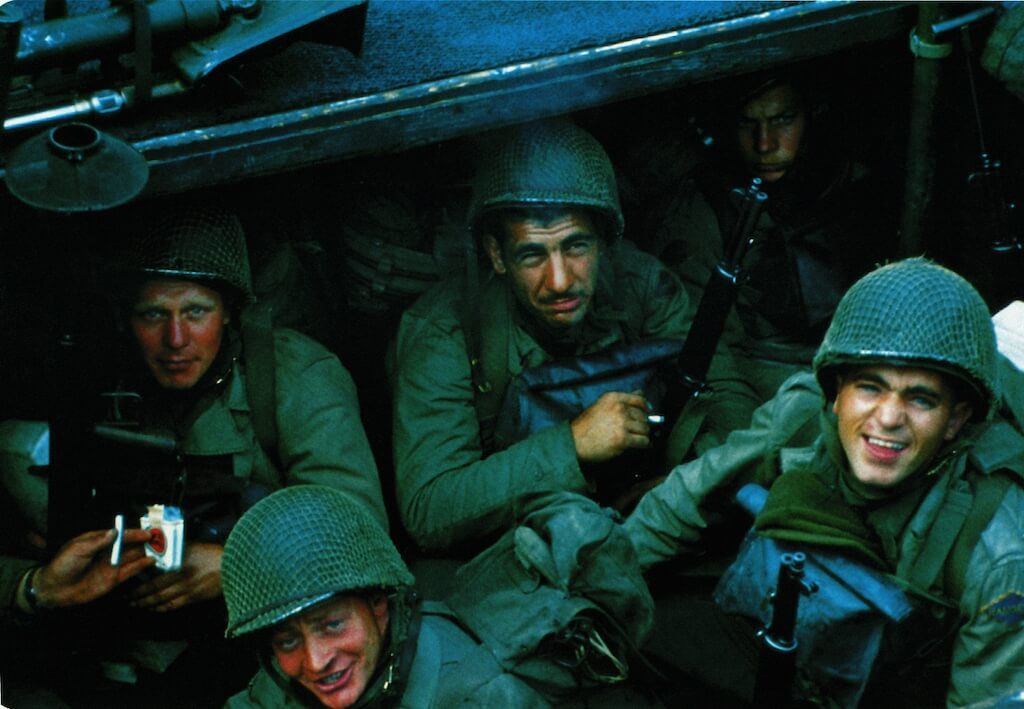
ADVERTISEMENT
United States Rangers from E Company, 5th Ranger Battalion boarded a landing craft assault vessel (LCA) in Weymouth harbor on June 4, 1944. About the ship bound for Omaha Beach were First Sergeant Sandy Martin, who was killed during the landing.
ADVERTISEMENT
Technician Fifth Grade Joseph Markovich, Corporal John Loshiavo, and Private First Class Frank E. Lockwood can be seen clutching a 60mm mortar, a Bazooka, a Garand rifle and a pack of Lucky Strike cigarettes. The men knew they were headed towards a bloody battle but looked shockingly calm at the time of this photo being taken.
ADVERTISEMENT
Training For D-Day
ADVERTISEMENT
ADVERTISEMENT

ADVERTISEMENT
The Allies knew storming Omaha Beach on D-Day was going to be a casualty-heavy but ultimately important battle they needed to win. In order to prepare for the fight of their lives, troops spent weeks training for the raid.
ADVERTISEMENT
American troops of the 7th Navy Beach Battalion can be seen here training in Britain before their deployment at Omaha Beach during the D-Day landings in 1944. Sadly, many of the men who arrived on the shoreline that day would perish, some wouldn’t even make it off the landing vehicles meant to carry them into war.
ADVERTISEMENT
Operation Overlord Normandy And A Large Canadian Infantry
ADVERTISEMENT
ADVERTISEMENT

ADVERTISEMENT
Operation Overlord would prove to be a major turning point and the storming of the beach on D-Day involved an international effort from the allied forces. In this photo soldiers of the 3rd Canadian Infantry Division can be seen on patrol near Juno Beach where they landed on D-Day on the outskirts of Bernieres-sur-Mer.
ADVERTISEMENT
The infantry division arrived on June 6, 1944, and was 14,000 strong when put on shore. Sadly, only 13,660 men would make it home after 340 soldiers gave their lives to end Hitler’s cruel reign of terror.
ADVERTISEMENT
The Near Complete Destruction Of A Nearby Town
ADVERTISEMENT
ADVERTISEMENT

ADVERTISEMENT
It was immediately apparent that Operation Overlord brought with it a lot of pain and suffering. Lifeless bodies strewn across the beach left a solemn feel to an otherwise crucial victory.
ADVERTISEMENT
It wasn’t just the devastation on the beach that highlighted the terror of that fateful day. In this photo, many jeeps from the United States Amry can be seen driving through the ruins of Saint-Lo. The French town was almost completely annihilated when 2,000 Allied bombers attacked German troops stationed in the area.
ADVERTISEMENT
The First Men To Storm Normandy On D-Day
ADVERTISEMENT
ADVERTISEMENT
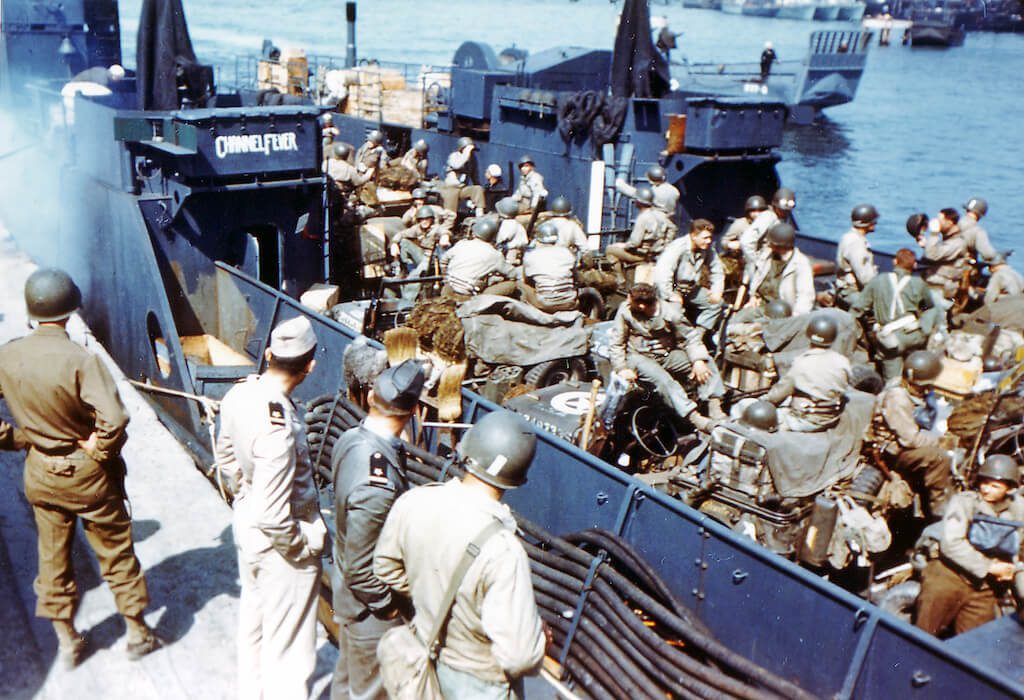
ADVERTISEMENT
Soldiers of the 1st Infantry Division of the United States Army are seen here as they board their Landing Craft Transport (LCT) named Channel Fever. The watercraft left from Southern England and landing in France.
ADVERTISEMENT
These brave men were part of the 1st Division which was among the first of the two divisions to storm Omaha Beach in Normandy, France. With German and other Axis troops awaiting their arrival, the group suffered high casualties while managing to secure Formigny and Caumont in the beachhead.
ADVERTISEMENT
The German Prisoners Of War
ADVERTISEMENT
ADVERTISEMENT
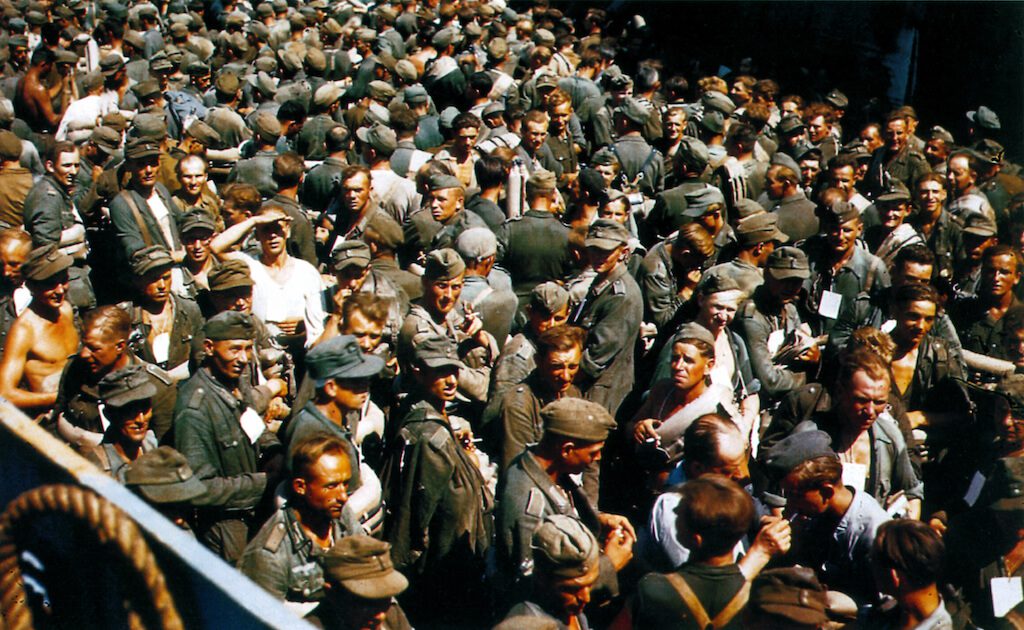
ADVERTISEMENT
D-Day claimed many Axis and Allied lives but there were also plenty of prisoners taken after the Allied forces managed to capture Omaha Beach in Normandy, France.
ADVERTISEMENT
Pictured is a large group of German soldiers who decided to surrender to Allied forces rather than taking their chances as their fellow troops were overpowered. This large group might seem impressive on the surface until we realize that 250,000 soldiers and civilians gave their lives first on the beach and in battles surrounding the countryside of the area.
ADVERTISEMENT
Eating On Top Of An Ammunition Box
ADVERTISEMENT
ADVERTISEMENT

ADVERTISEMENT
Grabbing a bite to eat during World War II often meant making the most of your surroundings whenever given the opportunity. In this photo, several American soldiers sat atop boxes of ammunition that were being continually stockpiled for the D-Day invasion.
ADVERTISEMENT
Captured by photographer Frank Scherschel, this photo was taken on May 1, 1944, in Stratford-on-Avon, England. Planning would continue and stockpiles would grow as Allied forces prepared to storm and ultimately take Omaha Beach.
ADVERTISEMENT
A Documentary Brings D-Day To Life In Color
ADVERTISEMENT
ADVERTISEMENT
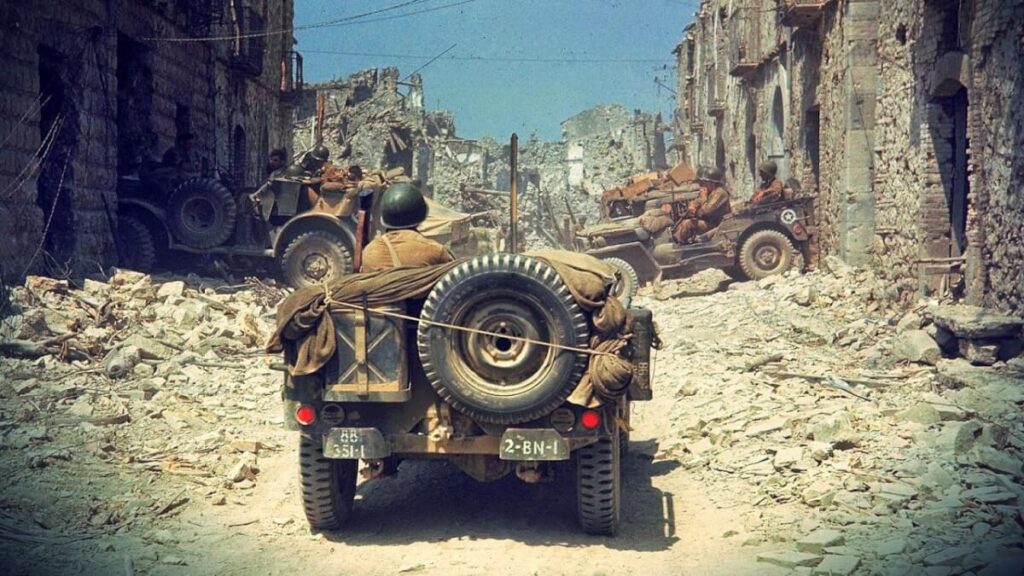
ADVERTISEMENT
Narrated by John Hurt, the documentary D-Day in Colour brought the now infamous battle to life by digitizing footage in vivid color. Released in 2004, the 120-minute film explores the lives of soldiers as they prepared to storm Omaha Beach and the effects the battle had on troops and the surrounding area.
ADVERTISEMENT
The photo above shows the clear devastation that occurred all throughout World War II. Entire cities, once thriving before Hitler waged war, were completely destroyed with almost no liveable structures remaining.
ADVERTISEMENT
Preparing For A Blood Battle
ADVERTISEMENT
ADVERTISEMENT

ADVERTISEMENT
Allied troops knew the battle in Normandy, France was going to cause a lot of casualties and injuries. In preparation for storming the beach ambulances were loading into the Landing Ship Tank (LST-357).
ADVERTISEMENT
This picture was taken at Portland Harbour, Dorset, before the D-Day landings in 1944. The large vessel would make the cross-channel journey in the hopes of providing much needed medical assistance as hundreds of thousands of men fought to end World War II. Sadly, many medical ships came under fire during the battle, despite generally accepted rules of war that allowed medical vessels to travel unharmed into battle.
ADVERTISEMENT
A Barrage Balloon Prepares For D-Day
ADVERTISEMENT
ADVERTISEMENT
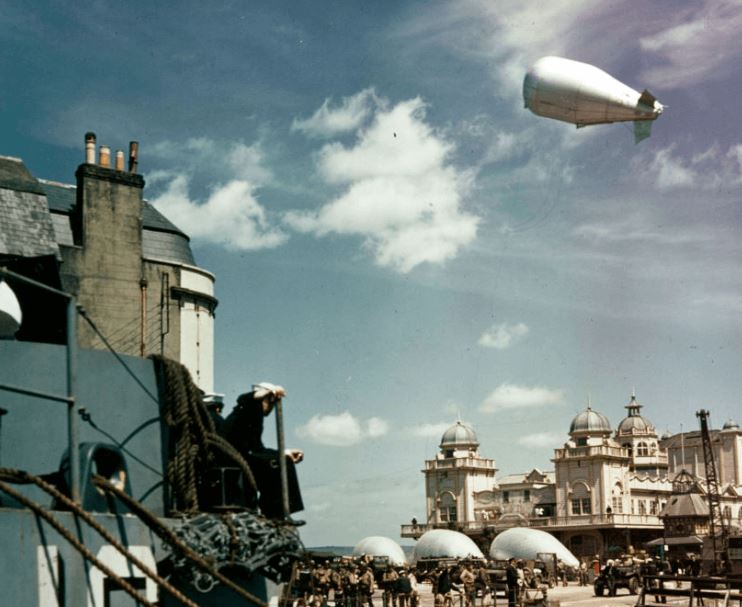
ADVERTISEMENT
Barrage balloons were large kite balloons used to defend against low flying aircraft sent to harm allied troops. The balloons were attached to heavy cables which posed a collision risk for attacking aircraft.
ADVERTISEMENT
In this picture, taken in Weymouth, Dorset, England on May 1, 1944, a barrage balloon is visible in the background. Several other balloons can also be spotted on the ground as troops prepared to deal a heavy blow to Hitler and his Nazi regime.
ADVERTISEMENT
Colorizing The Past In Striking Detail
ADVERTISEMENT
ADVERTISEMENT
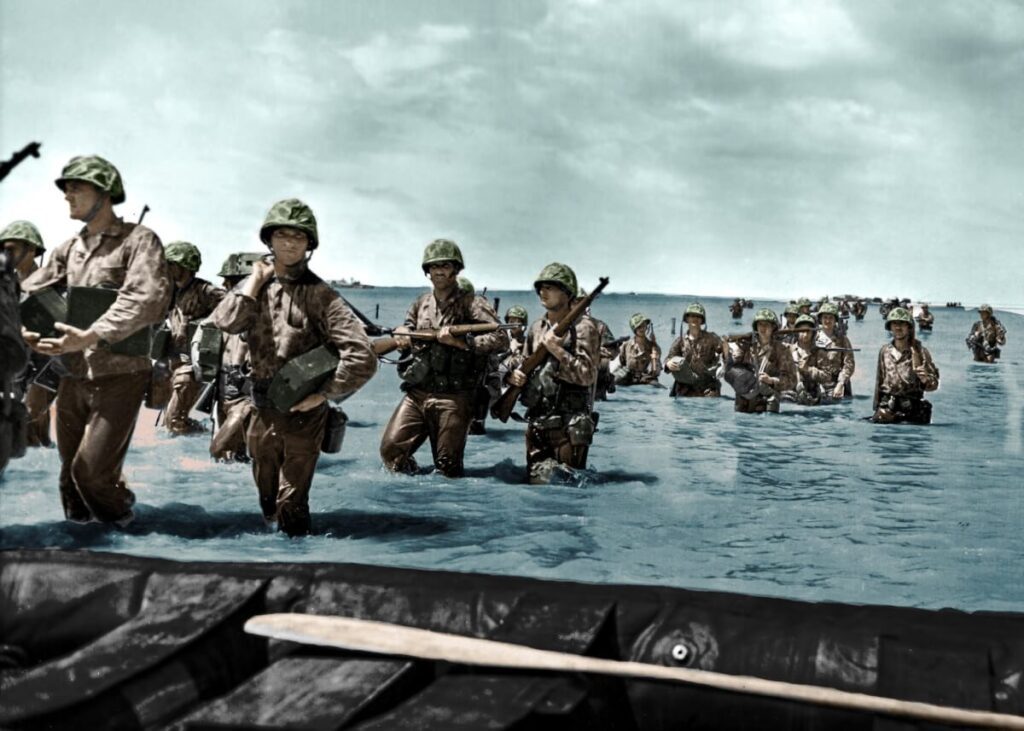
ADVERTISEMENT
With only a finite number of color D-Day photos, some photoshop experts have taken it upon themselves to add color to D-Day. This photo, originally in black and white, was part of a YouTube tutorial from David Galvan.
ADVERTISEMENT
Soldiers waded in water before making their way to the beach at Normandy, France. These soldiers were prepared for their water maneuvers after plenty of training but some of them would never make it to the beach front as German forces rained down numerous rounds of ammunition from their fortified vantage point.
ADVERTISEMENT
IX Bomber Command
ADVERTISEMENT
ADVERTISEMENT
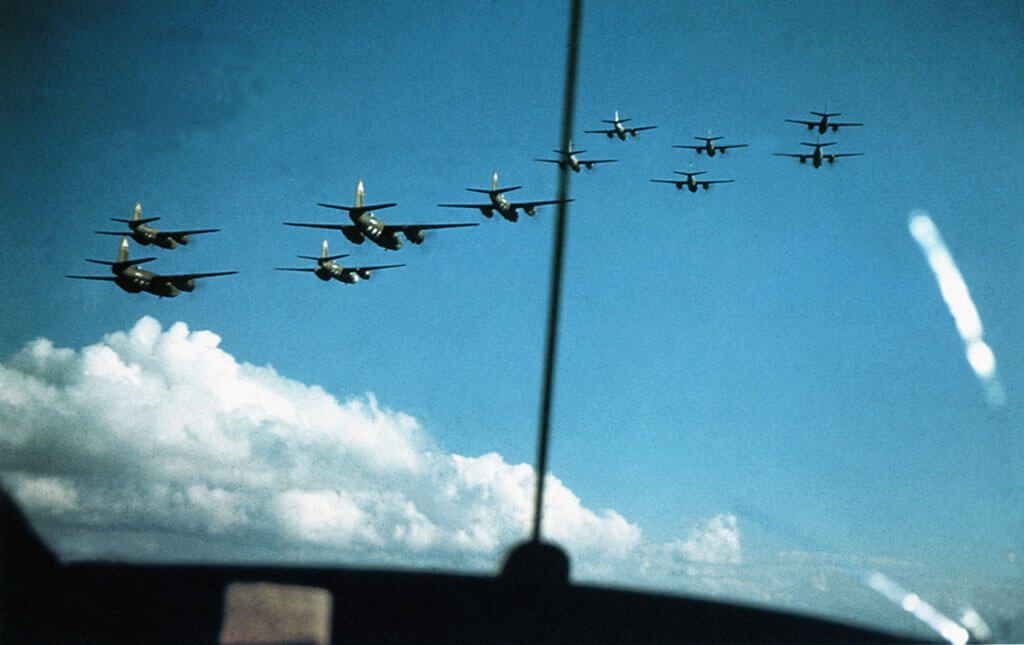
ADVERTISEMENT
Military planes flying in formation always make for a dramatic sight. These planes are B-26 Marauders and are part of the U.S. Air Force. The 344th, nicknamed the “Silver Streaks,” led the IX Bomber Command formations on D-Day. These operations first began in March 1944 with attacks on German-occupied Belgium, France, and the Netherlands.
ADVERTISEMENT
After the Normandy invasion, the 344th Group participated at Cotentin Peninsula, Caen, Saint-Lô, and at the Falaise Gap.
ADVERTISEMENT
Operation Overlord Normandy
ADVERTISEMENT
ADVERTISEMENT

ADVERTISEMENT
Operation Overlord was the codename for the Battle of Normandy, the pivotal June 6, 1944 operation. This colorized photo of the event depicts the Saskatchewan Regiment of the 2nd Canadian Infantry Division as they landed on Juno Beach near the town of Bernieres-sur-Mer in northwestern France.
ADVERTISEMENT
Three hundred and forty Canadian troops died on the beach that day, of around 14,000 who landed ashore. A total of 160,000 soldiers crossed the English Channel on that historic day.
ADVERTISEMENT
Preparing For Normandy Landing
ADVERTISEMENT
ADVERTISEMENT
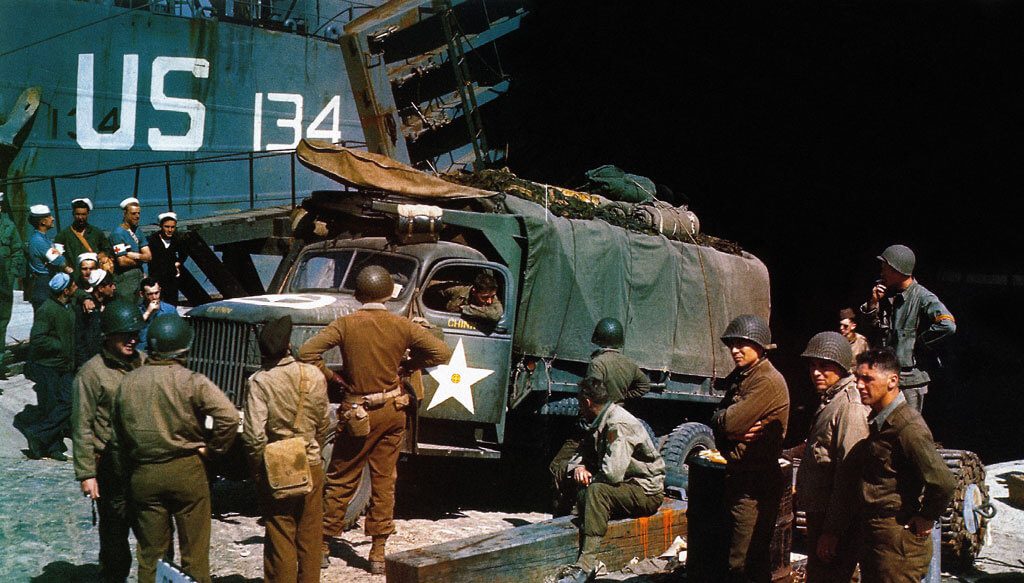
ADVERTISEMENT
In this photograph, we see a U.S. Army GMC truck as it is loading onto a landing ship. This took place at Portland Harbour, Devon, in preparation for the Normandy invasion.
ADVERTISEMENT
In the background is U.S. tank LST-134, part of Group 30 of LST Flotilla 12. It was scheduled to leave for Omaha Beach in France. LST-134 in the background is scheduled to depart for Omaha Beach in France.
ADVERTISEMENT
The 3rd Canadian Infantry Division
ADVERTISEMENT
ADVERTISEMENT
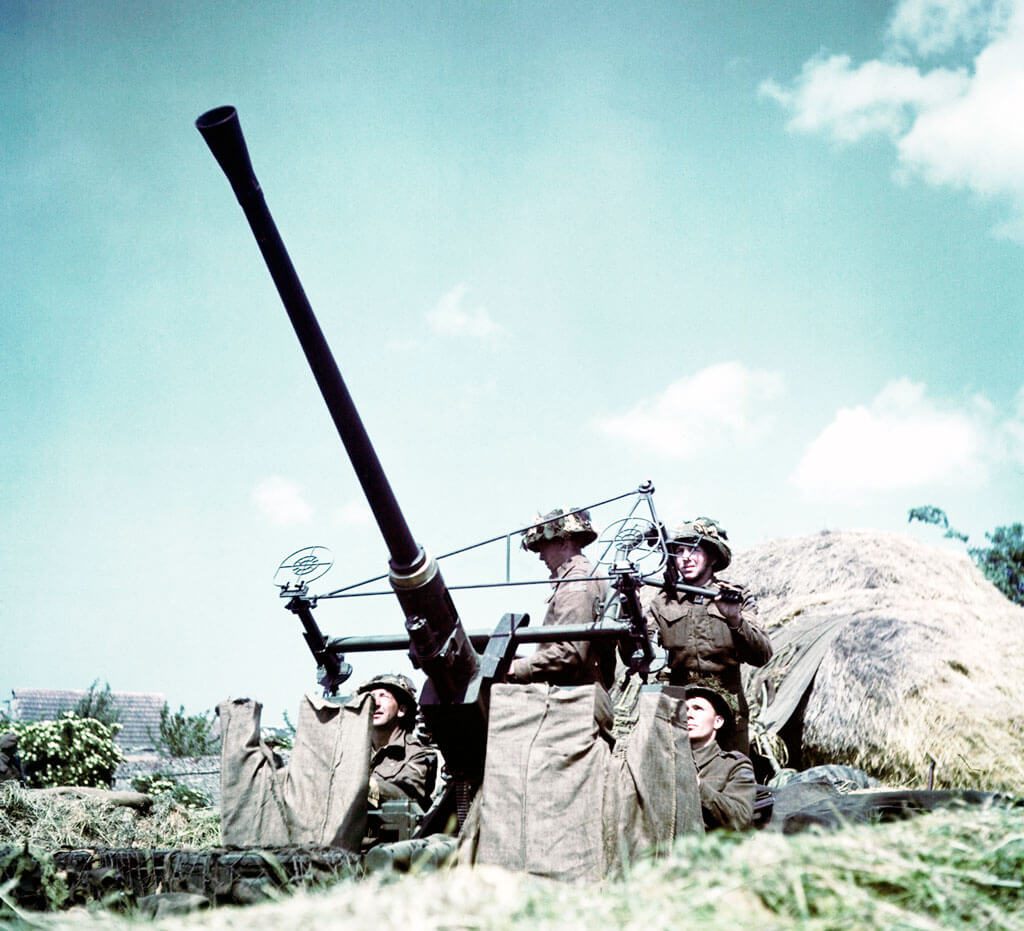
ADVERTISEMENT
Here is another photograph capturing Canadian contributions during Operation Overlord Normandy. This is the 3rd Canadian Infantry Division, whose formation was officially authorized on May 17, 1940. The 3rd Division suffered the most loss of life out of all the Canadian troops.
ADVERTISEMENT
German Luftwaffe warplanes were active in the area shown in the photo here. In response, the soldiers we see are erecting an anti-aircraft Bofors 40 mm/L60. This equipment is outfitted with a British-designed Stiffkey Sight.
ADVERTISEMENT
Prisoners Of War
ADVERTISEMENT
ADVERTISEMENT
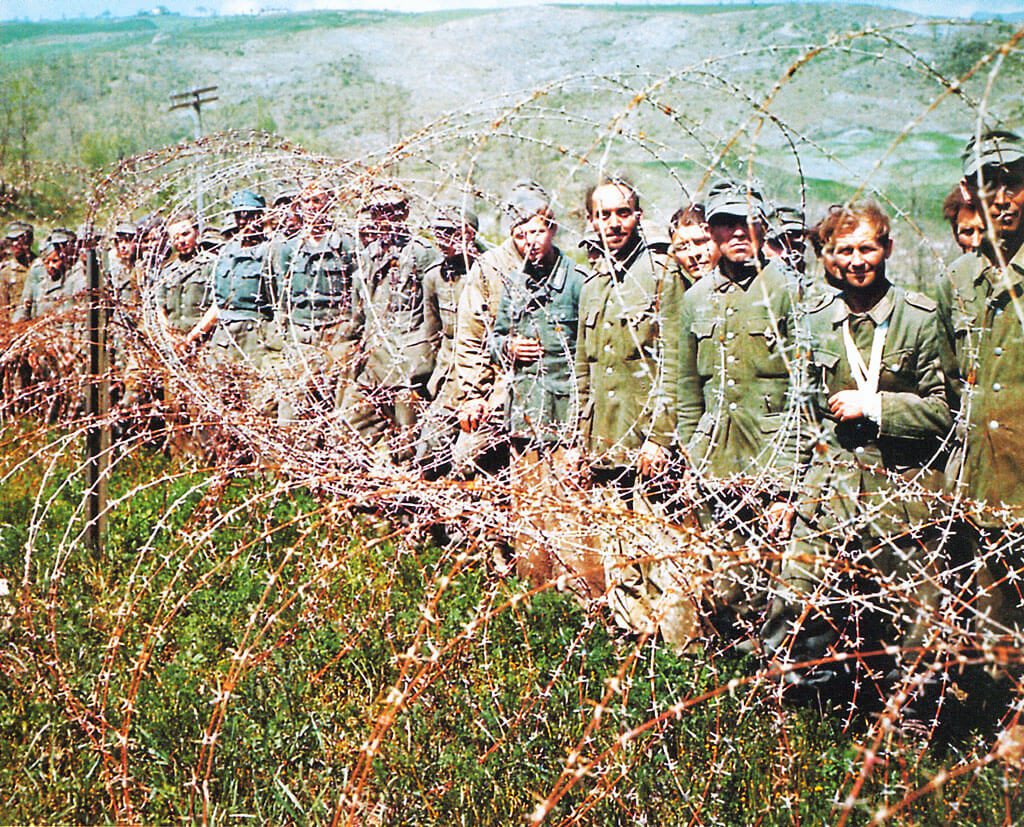
ADVERTISEMENT
In this dramatic photo, German prisoners of war are shown being blocked by a wall of barbed wire. During the Battle of Normandy, more than 200,000 German soldiers were captured.
ADVERTISEMENT
One of the first German soldiers to be taken in the battle shared his story with the BBC. Eighteen-year-old Private Helmut Roemer said, “[we] were exhausted and we decided to hand ourselves over to the British, thinking, ‘Either they will shoot us or they’ll take us prisoner.'”
ADVERTISEMENT
Landing Craft Infantry
ADVERTISEMENT
ADVERTISEMENT

ADVERTISEMENT
These United States Army troops are boarding a Landing Craft Infantry (LCI) ) in Southern England. This operation took place on June 5, the eve of D-Day. This is part of an Engineer Special Brigade which will participate in the D-Day landings.
ADVERTISEMENT
The large round silver objects we see in the background are “barrage balloons.” These were anti-aircraft balloons designed to thwart low-flying enemy aircraft.



